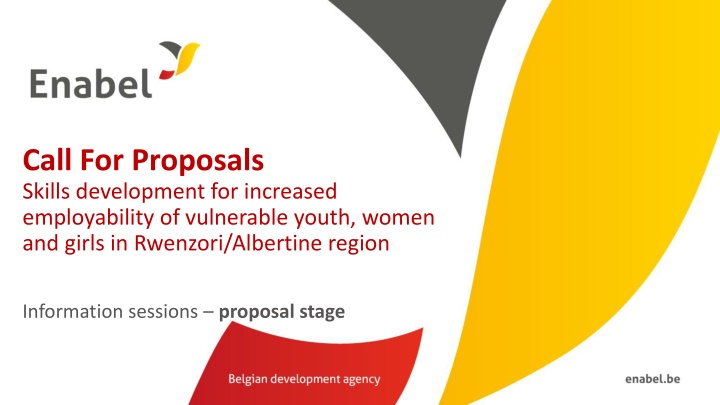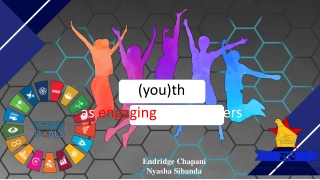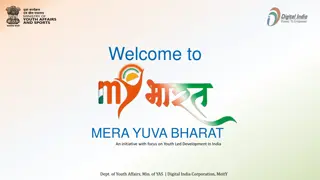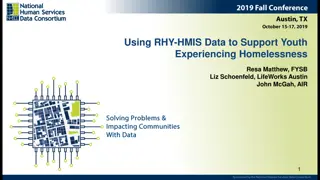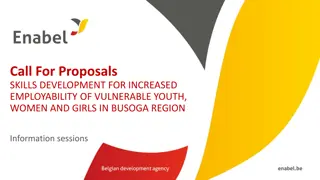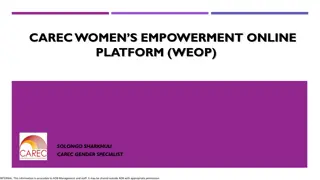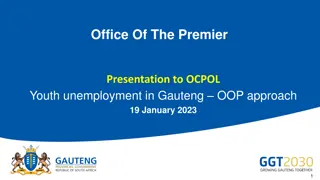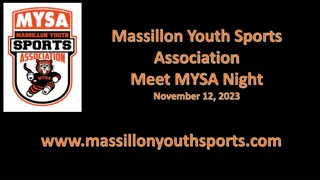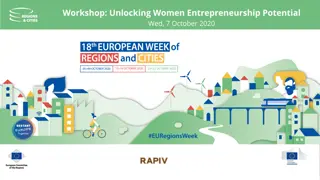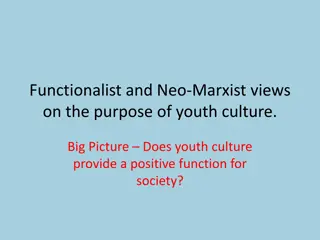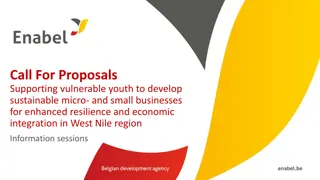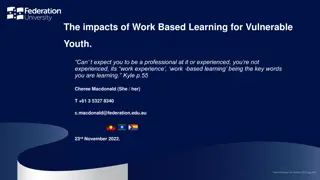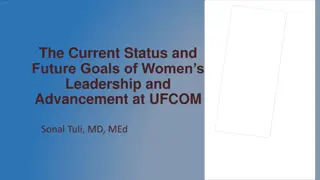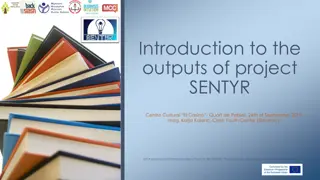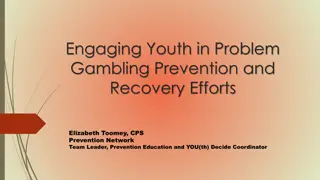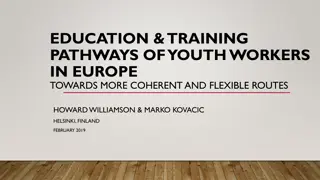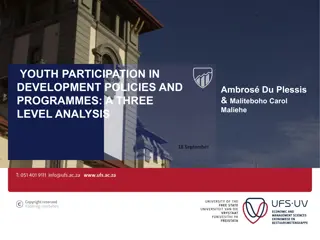Skills Development for Vulnerable Youth and Women in Rwenzori/Albertine Region
This proposal aims to enhance employability for vulnerable youth, women, and girls in the Rwenzori/Albertine region through skills development programs. The project focuses on improving livelihoods by providing equitable, qualitative, and innovative skill development opportunities, ultimately increasing access to employment support services and labor market-driven skills.
Download Presentation

Please find below an Image/Link to download the presentation.
The content on the website is provided AS IS for your information and personal use only. It may not be sold, licensed, or shared on other websites without obtaining consent from the author.If you encounter any issues during the download, it is possible that the publisher has removed the file from their server.
You are allowed to download the files provided on this website for personal or commercial use, subject to the condition that they are used lawfully. All files are the property of their respective owners.
The content on the website is provided AS IS for your information and personal use only. It may not be sold, licensed, or shared on other websites without obtaining consent from the author.
E N D
Presentation Transcript
Call For Proposals Skills development for increased employability of vulnerable youth, women and girls in Rwenzori/Albertine region Information sessions proposal stage
Presentation outline 1. Introduction & objectives 2. Concept Note selection process summary 3. General CN (stage 1) feedback 4. Proposal template a) Annex A; part B, proposal b) M&E logical framework, Indicators c) Discussion on budgeting (Budget template) 5. Next steps
2. Objective of the proposal orientation meeting Share common missing or wrong elements in the Concept Notes in the previous stage (General feedback) Refresher on the process and tools for full proposal development; templates, procedures, timelines relevant for phase 2. Respond to any questions and concerns regarding the CfP.
2. Objectives of the call Guidelines, annexes, clarifications (Q&A) and all other communication: https://www.enabel.be/grants/ Call reference number: UGA22005-10036 Call Title: SKILLS EMPLOYABILITY OF VULNERABLE YOUTH, WOMEN AND GIRLS IN RWENZORI/ALBERTINE REGION DEVELOPMENT FOR INCREASED
2. Call Objectives General objective Improve livelihoods of 2000 vulnerable youth through enhanced access to quality, development and employment support services demand-driven skills Specific objectives The provision of skills development is more equitable, qualitative, innovative, and increased employment opportunities labour market-driven for
2. Call Objectives 2 phased procedure - Concept note stage - Proposal stage
2. CN (stage 1) selection process Deadline for submission was 4th June 2024 5th 18th of June, Enabel carried out, administrative and admissibility checks and technical evaluation 98 concepts were received in AR (over 160 in total) 12 were late so they were disqualified 47 passed admissibility check and qualified for technical evaluation 21 scored min 30/50 (and 6/10 on Q12). 15 shortlisted concept notes invited for 2ndstage (absorbing 300% of total call volume)
3. General feedback on CN Mandatory activities not sufficiently incorporated: Labour market analysis Social inclusion strategies: PWDs, breast feeding mothers, selection criteria, etc. Assessment and certification (DIT/national/international certification). Integration of OSH standards and measures (materials + protective wear). Engagement of private sector in all stages to enhance employability and employment prospects Capacity building of co-applicant(s) based on an Organizational Capacity Assessment Provision of employment support/Business start-up support, tailored to specific employment/business needs (sustainable approach) Minimum 6 months extensive and support/business startup support services innovative post-training employment
3. General Feedback ctd Training approach not clear: clarity on training, WBL, & post training aspects & schedules Quality assurance mechanisms, cohort arrangements. Who handles the training?, who handles C&G/DIT certification especially where both the lead and co-applicants are NGOs. Is assessment budgeted for and considered in the activity plan? Involvement of PS in training, how and where the training will be conducted? (community Vs school based) WBL approach not well specified. How WBL providers will be selected?, How will applicants monitor and assure quality?, Who will supervise the trainees during the period?, What is the role of MCP s during WBL ? Private sector engagement (stakeholders) not clear: Selection, motivation, & non-financial capacity building of the PS/MCPs; certification, mentoring, skills transfer, ATP delivery, safe workplace, etc. Reminder: financial compensation is limited and only allowed in terms of daily allowances and travel expenses. Despite this, how will you ensure strong and sustainable PS engagement at all stages?
3. General Feedback ctd Budget not well aligned: Management cost > 30%, structure cost > 7% of the operation cost, unit cost; Start-up kits costs which should be less than 15%. Unit cost not being realistic. Mix up of management activities in operational budget section and vice versa. Post-training support approach not comprehensive: Linkages to private sector/financial institution, provision of business startup support is too vague (not sustainable), transition to wage employment/business, and access to value chains, local market, business networks, and roles of lead and co are not very clear. Activity Inconsistencies: Different activities in the narrative, action plan, budget, the log frame should align (= same number, same title, same content). Division of roles between the lead and co applicant, inception and closure phase. Trade selection: (how did they decide to select, what s the value addition why specifically is that trade, for those selecting multiple trades, what are the connections and evidences on capacity and expertise)
3. General Feedback ctd Community and environmental resilience not clear. Transversal themes such as environmental protection and sustainability not always integrated in the activities. External stakeholders not elaborate. Implementation in various regions: (how are they going to manage it; evidence on the capacity; connections amongst value chain and labor market actors in those districts) Ineligible activities included in the concept: Cash assistance for start-ups, start up capital Target beneficiaries not clear: selection criteria, segregation between refugees and host community, women & men etc. Critical innovations missing: digital economy; integration of environmental conservation/green economy; decent work; social inclusion, entrepreneurship promotion, tracking of the graduates, sustainability business start-up support and start-up kits sustainability approaches & utilisation.
4. Proposal template Annex A of the guidelines: PART B PROPOSAL Description of the action: 6 sections + logframe + budget The applicants experience for similar and other actions Co-applicant(s) experience for similar and other actions Administrative data on lead and co-applicant Mandate for each co-applicant signed Associates Declaration for lead applicant signed
Proposal: description of action Description of the action: 6 sections description, strategic approach, methodology, action plan, risks & assumptions, sustainability information requested -> follow guide on Do not change proposed activities only more details Needs analysis & project Coherence and logical flow Activity description in proposal = activity plan = logframe = budget How are you going to organize activities (implementation methodology: who / what / when / how)
Proposal: description of action Approach to identify WBL providers or mention all already identified relevant WBL providers How are you going to assure quality and alignment between training and WBL Post-training support to ensure sustainability e.g., start-up kits How are you going to ensure graduates will be employed integration of technology/digital economy // environmental conservation/ green economy // promotion of decent work // social inclusion and gender equity // synergies with other ongoing programmes
Proposal: description of action Complementary between lead and co-applicants + capacity building component Partnerships with the following actors: Private sector actor(s) Local government Local community Public institution(s) and other development partners
Administrative information Lead: Capacity to manage and perform actions (experience in sector) Resources Financial data Sources of financing Number of people employed Co-applicant: History of cooperation with applicant Capacity to manage and implement actions (experience in sector)
Associates Participate actively in the action, but are not eligible for grants and only qualify to receive daily allowances and travelling expenses. To be specified in part B of the application form. They need not to sign the mandate in proposal stage.
4a: Proposal template: M&E Use Annex C: logframe template and explain logic
Intervention logic Objectively verifiable indicators Sources and means of verification Hypotheses/Assumption To contribute to increased employment opportunities for youth, women and girls in the tourism and hospitality industry through increased access to skills development General objective 65% of the graduates are employed (Self and wage employment) six months after the training Tracer Studies NA (Impact) SO1: To equip 150 youth (50% female) with vocational skills in selected trades by 2024; 80% of the trainees are certified by DIT DIT certificates Timely release of funds SO2: To equip 150 youth (50% female) with entrepreneurship and other complementary soft skills Data base Certificates of completion Activity reports Specific Objectives 80% of the trainees succesfully complete the training Political stability (Outcomes) 70% of the Graduates utilising the startup kits 6 month after graduation Database Certificates of completion Activity reports SO3: To support the establishment of at least 5 new youth-led group businesses by 2024 Number trainees Assessed by DIT Number of beneficiaries enrolled Admission list Attendance list DIT assessement List RA 1.1: 150 youth (50% female) equipped with non- formal vocational skills in tour guiding etc etc Trainees are committed to complete the training Number of trainees trained Expected Results (Outputs) Number trainees Assessed by DIT Number of beneficiaries enrolled RA 2.1: 150 youth (50%females) are equipped with entrepreneurship and life skills Attendance lists, and group business plans ocial, economic political environment Number of trainees trained RA 3.1: Beneficiaries are linked to financial service providers; Number of beneficiaries linked to financial services Inputs Willingness of Financial service providers Attendance lists for linkage meetings A1.1.1 Conduct a one-day project inception meeting 2,990,000 Venue, meals, transport, and stationery Radio jingles, fuel, SDA, stationery & refreshments Training equipment, materials, protective gear,, lunch, transport subsidy Typesetting & printing Consultant, stationery, lunch, fuel, & mobilization A1.1.2: Conduct mobilization and selection 150 project beneficiaries A1.1.4 Training 150 vulnerable youth in selected trades A2.1.1: 1,938,000 Favorable Security situation in the country, timely release of funds from Enabel, trainees commitment; and favorable SOP reguarding the COVID-19 situation in the county. Activities 153,839,000 4,200,000 A2.1.2: 38,264,000 A3.1.1: Provide start-up kits Fuel & stationery 1,278,000
4b: Proposal template budget The budget need to be coherent with the activities in the narrative & action plan NUMBERING: Activity 1 in the narrative planning need to be transferred to a budget line for activity 1 TIMING: if you plan activity 1 in quarter 1 only, then you will only foresee a budget in quarter 1 for that activity CODING: Codes correspond with the Logframe: Specific Objective, 01 Result number one,01 Activity Number one under result no One.A0101.3rd level relates to sub activities e.g A010101,A010102 Budget min 150,000 max 500,000 euro
4b: Proposal template budget On a daily basis you will work with UGX, but the official max grant amount is in euro which you cannot exceed, so follow up of execution in euro is needed. FX rate of UGX 4000: 1 EUR (grantees can use their own exchange rate (based on a reliable source) to estimate the budget) Exchange rate losses are ineligible costs and should be covered by the grantees themselves (e.g. through structure costs). Additionally, since the purpose of the grant is not to make money, any gains (exchange or interest) made on the funds received from Enabel must be re-used for the activities after Enabel approval.
4b: Proposal template budget The budget is broken down in 3 cost components as below; 1. Operational costs (actual activity costs) + general means cost 2. Management costs (costs to support the management team) 3. Structure costs ( 7% max of eligible operational costs)
4b: Proposal template budget 1 Operational costs: necessary and indispensable cost for achieving the objectives and results of the action, including the cost for achieving verifiable deliverables Ex : fees for instructors, consultancy fees, fuel for transporting, workshop costs, materials, food for trainees, fees for trainees etc. 2 Management costs: identified costs related to management, supervision, coordination, monitoring, control, evaluation and financial audit which specifically originate in the implementation of the action or the justification of the Grant Ex : Salary for staff, Mid-term evaluation, special audit costs training 3 Structure costs: costs related to the achievement of the social purpose of the beneficiary, which cannot be separated or charged to the budget of this action even though they are affected by the implementation of the action. They are a max of 7% of the eligible operational costs. Ex: supporting staff (those that cannot be justified under management costs through timesheets e.g., procurement), water & electricity & internet of the office etc.
4b: Proposal template budget What are the rules concerning structure costs? - The percentage (max.7%) must be justified before signature of the Grant Agreement and correspond to the general structure costs of the grantee - It s a lump-sum and maximum 7% of operational costs - Once the % has been set and confirmed by the analysis of the grantee s accounts, no supporting document have to be provided by the grantee. In the reporting, it just appears as a separate line at the end (+ 7%).
4b: Proposal template budget Ineligible costs: Expenses that are included in the ineligible list (see guidelines) Expenses that are incurred before or after the duration of this grant agreement Expenses that cannot be identified, verified and are not included in the grantee's accounts Expenses not in line with applicable legal fiscal and social provisions Expenses that are not reasonable, justified, not respecting the principle of good financial management, in particular concerning cost efficiency and effectiveness Expenses not in line with the action plan, not necessary to achieve the results No contributions in kind are considered
Ineligible costs in guidelines 1. Accounting entries not leading to payments 10. Subcontracting by means of service or consultancy contr acts to personnel members, Board members or General Assembly members of the organisation subsidized 11. Any sub-letting to oneself 12. Purchases of land or buildings; 13. Compensation for damage falling under the civil liability of the organisation 14. Employment termination compensation for the term of notice not performed 15. Purchase of alcoholic beverages, tobacco and derived products thereof 16. Grants to sub-beneficiaries 2. Provisions for liabilities and charges, losses, debts or possible future debts 3. Debts and debit interests 4. Doubtful debts 5. Currency exchange losses 6. Loans to third parties 7. Guarantees and securities; 8. Costs already financed by another grant 9. Invoices made out by other organisations for goods and services already subsidized
4b: Proposal template budget Budget proposal may not differ more than 20% from the initial concept note budget and must remain within the minimum and maximum amounts Modification between results leading to a variation not greater than 15% of amounts initially planned. Modification between activities of the same result leading to a variation not greater than 25% of the amounts initially planned. Changes between operational costs (A) and management costs (B) are not allowed without an amendment. Changes to structure costs (C) are not allowed.
4b: Proposal template budget Budget presentation in excel (Annex B of the grant agreement)
5. Next steps Deadline for clarification requests to the contracting authority 29-July-24 5:00 pm Response to clarification requests are given by the contracting authority 8-August-24 5:00 pm Deadline for the submission of the proposals 19-August-2024 5:00 pm Opening, administrative and admissibility checks of proposals N/A 20-August-2024 Technical evaluation of proposals 20-September-2024 N/A
5. Next steps Clarification requests Deadline 29-July, 2024, 5 PM (21 days before submission deadline) Requirements: sdf.grants@enabel.be only Subject line with reference number call for proposals: (UGA22005-10036) + full name applicant Clarifications will be published by Enabel on https://www.enabel.be/content/enabel-grants with final update by 8-August-24 at 5 PM
5. Next steps Submission full proposal Deadline 19 August 2024, 2024, 5 PM Required documents (!): ANNEX A, PART B = proposal application form pdf format ANNEX B = Budget Excel format(!) ANNEX C = Logical Framework pdf format Download all templates from https://www.enabel.be/content/enabel-grants
5. Next steps Applications must be submitted in electronic version, one PDF file containing grant application documents and annexes except for the budget (annex B) which is to be sent in a protected Excel format and sent to this email: sdf.grants@enabel.be. Enabel will send a confirmation upon receipt of the submission. The email subject line must bear the Call for Proposals reference number, Call for Proposals title and full names/address of the applicant Applications sent by other means (for example by fax, post, courier) or sent to other e-mail addresses will be rejected. Applicants must ensure that their application is complete. Incomplete applications may be rejected.
5. Next steps Send timely and do not wait until the last moment ! Any submission after 5 PM is not allowed All templates (A, B and C) have to be fully completed and the template itself cannot be modified Any error or inconsistency in the proposal (eg in the budget calculation) may lead to rejection of the application Only the proposal (annex A), budget (B) and logframe (C) will be evaluated. It is therefore very important that these contain ALL the relevant information regarding the action. No supplementary annex must be sent
5. Next steps Concept note may not be modified by the applicant in the proposal (no substantial activities/approaches) change to key Requested funds may not differ more than 20% from the initial estimate/requested contribution and within minimum/maximum amounts
5. Next steps PART 2 Request certificates and supporting documents relating to the grounds for exclusion (see 2.1.1 (2)) TBD on technical evaluation* 5:00 pm Receipt of certificates and supporting documents relating to the grounds for exclusion Onsite organizational analysis of the successful applicants after technical evaluation 8-October, 2024* (15 days since request) TBD on technical evaluation* 5:00 pm N/A- Selection Committee meeting (physical pitching of pitching of provisionally selected candidates) Legal check and grant signature N/A 29-31/OCT/2024 N/A 12-Nov-2024 Start grant implementation 12-Nov-2024 N/A
5. Next steps PART 2 After technical evaluation: Ranking Pre-selection of highest ranked that absorb call volume Reserve list of those that come below in the ranking and passed technical evaluation
5. Next steps PART 2 Pre-selected applicants will be invited to submit time = 15 days Criminal record clearance (Interpol) certificate for the main authorized representatives of your organization (e.g. chairman of the board of directors AND the executive director) those that will sign the grant agreement Can take 2 weeks, ask timely!! Tax clearance certificate from Uganda Revenue Authority (URA) NSSF Clearance Certificate Documents cannot be older than 2 years
5. Next steps PART 2 Organisational assessments Assessment to confirm whether applicant has the capacity to implement the proposed activities. The purpose is to verify general characteristics, technical capacities, control environment, financial management, audit, procurements and context. Done by consultant & Enabel Visits of half a day to 1 day Can be organized on short notice be prepared
